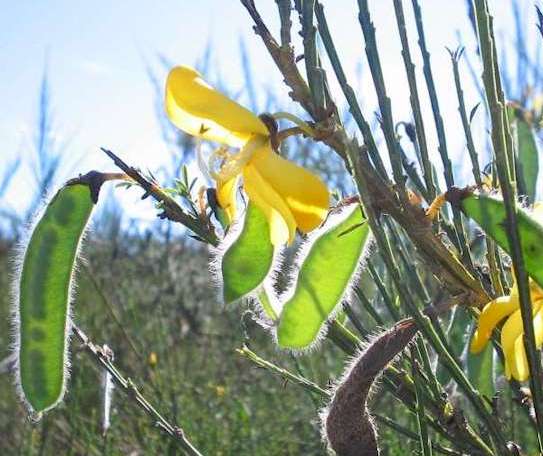(Cystisus scorparius (L.) Fabaceae)
Category 4: Watch list. Category 4 plant species are plants that are invasive and may cause significant economic or environmental impacts if allowed to become established in Montana. Research and monitoring for category 4 plant species may result in future listing as a category 1, 2, or 3 noxious weed in Montana. Plant species designated as a category 4 plant are prohibited from sale in or into Montana. AUTH: sec. 80-7-802, MCA. IMP: sec. 7-22-2101, MCA.
Reason: The Montana Dept. of Agriculture received recommendation from the Noxious Weed List Committee to create a Category 4 designation and to list scotch broom in this category. The intent of Category 4 listings is to prohibit nursery trade for plants that are invasive and may cause significant economic or environmental impacts if allowed to become established in Montana.
 Roots: The
root system consists of a taproot that can grow to be two feet
in length, with large, shallow lateral roots. (1) (4)
Roots: The
root system consists of a taproot that can grow to be two feet
in length, with large, shallow lateral roots. (1) (4)Stems/Leaves: The leaves are mostly triflouride with many alfalfa-like leaves, each about a 1/2 inch long. The stems are dark green and usually angled. They have branches that spread slightly from the main stem. (2)(4)
Flowers: The flowers are bright yellow and sometimes have red around their center. The flowers are on short stalks. The main flowering time for Scotch broom flowers is between April and June. (2)(4)
Fruits and Seeds: Scotch broom is capable of spreading quickly. This is due to their ability to produce 60 seed pods by their second year. Seeds can survive in the soil for up to 80 years! (4)
Probable Entry: Scotch broom entered California and other parts of North America by being sold as an ornamental flower. In some places, Scotch broom is still sold as an ornamental flower. This is illegal in Montana (to sell or plant) as Scotch broom is a Category 4 noxious weed [see above].
Favorable Infestation Area: Scotch broom is usually found in grasslands and hillsides. They need some sun and can grow in relatively cold climates.
Life Duration: Scotch broom can live for 10-15 years. They start to reproduce at 2-3 years old. (4)
Methods of Control:
Biological Control: A twig-mining moth, Leucoptera spartifoliella, has been shown to eat Scotch boom. However, the moth is heavily parasitized and largely ineffective. The seed weevil Apion fuscirostre has been fairly effective. Larvae consume the seeds and may assist in slowing the spread of the plant but will not reduce an existing stand. The shoot tip leaf tying moth Agonopterix nervosa can be found at most sites of infestation. (1) (3)
Cultural Control: Pulling and burning have been found to be effective. Goats can eat Scotch broom without harmful effects. Planting native trees and shrubs in and around broom stands can eventually help minimize infestations by shading. (3) (4)
Chemical Control: Common herbicides have been shown to be fairly effective if applied correctly. Trichlorophenoxy acetic acid is effective when applied to the foliage or stump. (3)
Links:
http://extension.oregonstate.edu/catalog/html/pnw/pnw103/
http://www.co.stevens.wa.us/weedboard/htm_weed/sb.htm
http://www.shim.bc.ca/invasivespecies/_private/Scotchbroom.htm
http://www.invasivespeciesinfo.gov/plants/scotchbroom.shtml
http://en.wikipedia.org/wiki/scotch_broom
Bibliography:
1. Scotch broom Cystius scoparius. July 1994. Oregon State University Extension Service, Washington State University Extension, University of Idaho Cooperative Extension System, and the U.S. Department of Agriculture cooperating. February 12, 2008. http://extension.oregonstate.edu/catalog/html/pnw/pnw103/
2. Scotch Broom. December 17, 2007. Stevens County Weed Control Board. February 2, 2008. http://www.co.stevens.wa.us/weedboard/htm_weed/sb.htm
3. Scotch Broom. 1998. Langley Environmental Partners Society. February 5, 2008. http://www.shim.bc.ca/invasivespecies/_private/Scotchbroom.htm
4. Scotch Broom. LeBlanc, John. W., et. al. Date of posting unknown. February 7, 2008. http://www.countyofplumas.com/agcomm/brochures/scotchbroom.pdf
By: M. Steerman and H. Hobbs 2/2008. Back to Weed ID
mtwow.org HOME